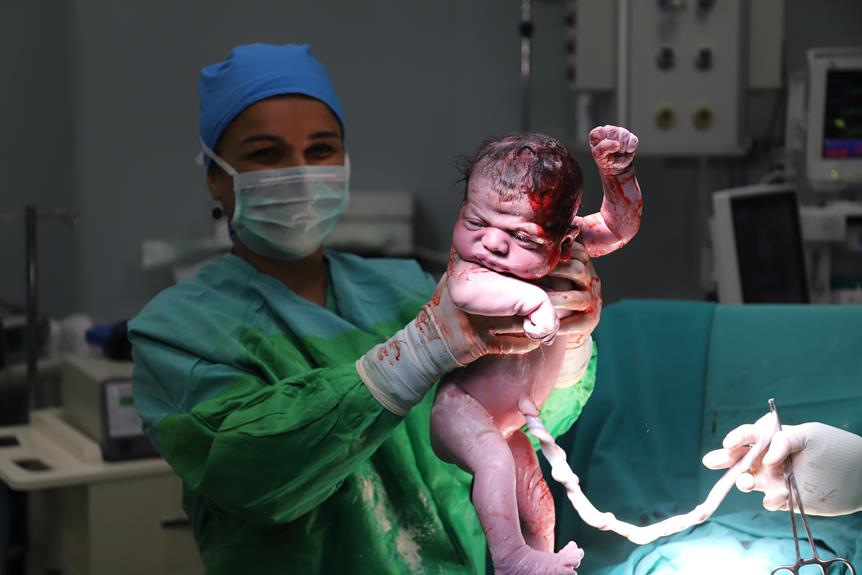Medical Malpractice: Birth Defects Vs. Birth Injuries
This article provides an in-depth analysis of birth defects and birth injuries in the context of medical malpractice. It explores the legal implications, the importance of early detection, the consequences of negligence, and the rights of patients. The aim is to enhance understanding of these complex issues, and the responsibilities of healthcare providers, thereby promoting patient rights and adherence to medical standards.

Key Takeaways
- Birth defects are genetic conditions that result from the child's DNA, while birth injuries are preventable conditions that occur during the delivery process.
- Birth defects are not caused by the doctor or parent's actions, whereas birth injuries can be the result of medical malpractice during pregnancy or birth.
- Birth-related medical malpractice can lead to three types of lawsuits: birth injury, wrongful birth, and wrongful pregnancy.
- Failure to detect or inform parents about a birth defect can be considered medical malpractice, and doctors are expected to provide the best care and use available resources to detect and diagnose birth defects.
Defining Birth Defects and Birth Injuries
Commonly, birth defects are often misunderstood as birth injuries, but it is imperative to understand that the former is a genetic condition that is not preventable, while the latter occurs during the delivery process and may be the result of medical malpractice. Common birth defects, such as Down Syndrome or congenital heart disease, can drastically impact families, often requiring lifelong care and significant financial resources. On the other hand, preventable birth injuries, like cerebral palsy or brachial plexus injuries, caused by negligence during delivery can lead to legal consequences for medical professionals. These can include lawsuits for medical malpractice, resulting in potential financial compensation for affected families to aid in the management of the injury. Thus, understanding the distinction between these two is crucial for both healthcare providers and parents.
The Legal Landscape of Birth-Related Medical Malpractice
Navigating the legal landscape of birth-related medical malpractice requires a deep understanding of the differences between birth defects and birth injuries, and the ability to clearly discern situations where negligence has potentially occurred. Birth defects, resulting from genetics, are not grounds for a malpractice suit, unlike birth injuries, which are preventable and may reflect negligence. Potential legal defenses in birth-related medical malpractice cases often hinge on complex medical and legal considerations. Professionals need to ascertain whether the standard of care was violated and if the negligence directly caused the birth injury. Establishing causation, demonstrating financial damages, and understanding the nuances between birth injuries and defects are essential elements in navigating this legal landscape. Mastery of these intricate details is crucial in effectively handling these sensitive cases.
Understanding the Types of Birth-Related Medical Malpractice
The types of birth-related medical malpractice encompass a broad spectrum, from birth injuries due to negligence during the delivery process to wrongful birth and wrongful pregnancy cases. Preventing birth-related medical malpractice involves ensuring adherence to medical standards, enhancing communication, and facilitating informed consent. The emotional toll of birth defects and birth injuries can be severe, with families facing financial, physical, and psychological challenges. While birth defects are typically not preventable, birth injuries are often the result of negligence and thus, preventable. Through improved awareness, professional development, and system-level changes, the incidence of birth-related malpractice can be reduced. However, when malpractice does occur, legal recourse may be sought to compensate for the emotional and financial burdens incurred.
The Impact of Birth Defects on a Child’s Life
Why, despite the challenging circumstances, do some children with birth defects manage to thrive, and what factors contribute to their resilience? The answer lies in a complex interplay of genetic, environmental, and personal factors. The emotional impact of birth defects can be mitigated by strong support networks, including loving families, skilled healthcare providers, and inclusive communities. These elements provide the necessary emotional, physical, and psychological resources that foster resilience. Early intervention programs play a crucial role in addressing the long term effects of birth defects on development. Personalized therapies and educational programs help in maximizing the child's potential and improving their quality of life. Furthermore, the child's inherent characteristics such as temperament, cognitive abilities, and adaptability also contribute to their resilience.
How Birth Injuries Occur and Their Consequences
Despite a physician's best intentions, a patient's birth injury can occur due to medical negligence, leading to severe physical and mental consequences for the newborn. Causes of birth injuries vary, but common factors include improper use of delivery instruments, delays in performing necessary cesarean sections, or mismanagement of neonatal jaundice. Such negligence can result in conditions like cerebral palsy, Erb's palsy, or hypoxic-ischemic encephalopathy. The long-term effects of birth injuries can significantly impact the child's life, manifesting as developmental delays, physical disabilities, or cognitive impairments. Moreover, these injuries place emotional and financial burdens on families. It's imperative for healthcare providers to prioritize patient safety to prevent birth injuries and ensure the best possible outcome for both mother and child.
The Role of Medical Professionals in Detecting Birth Defects
In prenatal care and diagnosis, medical professionals play a pivotal role in detecting birth defects, and their timely intervention can significantly influence the course of treatment and prognosis. The role of prenatal testing is critical in this process, as it allows for early identification of potential genetic anomalies. Ultrasounds, blood tests, and other diagnostic procedures provide invaluable information about the fetus' health and development. However, the implications of late diagnosis can be severe. A delayed diagnosis can limit treatment options and preparation time, possibly leading to further complications. It can also deprive parents of the opportunity to make informed decisions about the pregnancy. Therefore, timely detection and communication of birth defects are essential aspects of prenatal care and medical professionalism.
Medical Malpractice and Failure to Detect Birth Defects
While medical professionals bear a significant responsibility in detecting birth defects during prenatal care, failure to do so can lead to allegations of medical malpractice, particularly if this oversight results in preventable harm to the child or mother. In medical negligence cases, failure to detect birth defects can have severe repercussions. The emotional toll inflicted on parents can be devastating, often accompanied by significant financial burdens. Early detection of genetic anomalies can lead to informed decisions about care, potential treatments, or in some cases, termination of pregnancy. It is crucial for medical practitioners to adhere strictly to guidelines and ensure rigorous prenatal screening procedures are in place. When these standards are not met, and it results in harm, it constitutes medical negligence, warranting legal action.
The Complications From Undiagnosed Birth Defects
We must consider the severe complications that can arise from undiagnosed birth defects, as they can significantly affect a child's development and quality of life. Undiagnosed defects may lead to complications in childbirth, including preterm labor, distress, and neonatal morbidity. They can also cause cognitive and physical disabilities, translating into long term effects such as reduced independence, lower educational attainment, and diminished employment opportunities. These consequences underscore the importance of prenatal diagnosis and effective communication between healthcare providers and expectant parents. It is critical for parents to understand potential risks and complications so that informed decisions can be made. A failure in this aspect can be considered medical malpractice, with substantial legal and ethical implications.
Key Elements of a Birth-Related Medical Malpractice Claim
Before proceeding with a birth-related medical malpractice claim, it is essential to understand that three key elements must be present: negligence, causation, and financial damages. Negligence refers to a breach of the duty of care in the medical profession. Causation signifies that the negligence resulted directly in the injury or condition, and financial damages represent the measurable impact of the negligence on the patient's life, such as disability, lost income, or significant medical expenses. Evaluating compensation in these cases involves careful assessment of these elements. The consequences of birth-related medical malpractice can be severe, involving physical, emotional, and financial hardship. Thus, understanding these key elements is crucial in pursuing a birth-related medical malpractice claim.
The Concept of Negligence in Medical Malpractice Cases
In medical malpractice cases, negligence is often the pivotal factor, and it entails the violation of the standard of care by a healthcare provider, leading to harm or injury to the patient. Negligence standards in healthcare are defined by what a reasonably competent professional in the same field would have done under similar circumstances. If these standards are not met, legal implications can arise, potentially resulting in severe penalties for the healthcare provider. The concept of negligence in medical malpractice is complex, involving a thorough examination of the healthcare provider's actions or omissions. The patient must demonstrate that the provider's negligence directly caused the harm or injury. Therefore, understanding the negligence standards and the legal implications involved is critical in medical malpractice cases.
The Importance of Causation in Medical Malpractice Lawsuits
The plaintiff's ability to establish causation in a medical malpractice lawsuit is critical, as it connects the defendant's negligence to the harm or injury suffered. This is particularly significant in birth-related medical malpractice, where the consequences can be life-altering. Proving negligence in birth injury cases hinges on demonstrating that a healthcare provider's actions or inactions directly led to an adverse outcome. This involves establishing a causal link between the medical practitioner's deviation from the accepted standard of care and the resulting injury. Understanding the nuances of causation in these cases is paramount, as it's often complex due to the myriad of factors involved during birth. Furthermore, concrete evidence and expert testimony play a crucial role in substantiating claims of causation, thereby strengthening the plaintiff's case.
Evaluating Financial Damages in Birth-Related Medical Malpractice
Arguably, the most challenging aspect of birth-related medical malpractice cases involves accurately evaluating the financial damages incurred due to negligent care. These damages are not merely transactional, but encompass the potentially devastating long-term effects on the child and family's quality of life. Estimating costs for future medical needs, therapy, educational support, and loss of earning potential requires expert analysis and foresight. Additionally, non-economic damages such as pain and suffering, emotional distress, and loss of enjoyment of life are subjective and can vary greatly. The aim of compensation options is to provide a measure of financial relief to the affected parties, however, quantifying these damages accurately and fairly remains a complex task, requiring the expertise of legal and medical professionals.
The Legal Process for Filing a Birth-Related Malpractice Lawsuit
Navigating through the legal process for filing a birth-related malpractice lawsuit, which involves collecting substantial evidence of negligence and causation, requires not only a deep understanding of medical terminologies but also a sound knowledge of legal procedures. The steps involved in a birth-related malpractice lawsuit include identifying potential negligence, collecting medical records, consulting medical experts, and filing a complaint. Hiring legal representation is critical as this complex process requires expertise in both medical and legal fields. Legal representation can guide the victims through the legal landscape, ensuring that all necessary steps are followed and that the victim's rights are protected. The importance of legal representation in birth-related malpractice cases cannot be overstated, as the success of these cases often hinges on the quality of the legal counsel.
Coping and Support for Families Dealing With Birth Defects or Injuries
While the legal aspects of birth-related malpractice cases are significant, it is equally essential to focus on the coping mechanisms and support systems for families dealing with birth defects or injuries. The emotional turmoil and psychological stress can be overwhelming, making therapy options crucial. Therapies can range from physical and occupational to speech and behavioral, depending on the nature of the birth defect or injury. Additionally, support groups offer an invaluable platform for families to share experiences and exchange advice. These groups can often provide a sense of community and understanding that is essential during such challenging times. Ultimately, it is a combination of therapy options and support groups that offers the most comprehensive aid to families navigating the realities of birth defects or injuries.
Frequently Asked Questions
What Types of Birth Defects Are Most Commonly Missed in Prenatal Testing?
Advances in prenatal testing have significantly improved detection rates for various birth defects. However, certain conditions, such as microdeletions, small chromosomal abnormalities, and some heart defects, may still be overlooked. The importance of genetic counseling cannot be overstated, as it guides expectant parents through understanding the possibilities and limitations of prenatal testing. This ensures they are fully informed, enabling them to make the best decisions for their family.
How Often Do Wrongful Pregnancy Cases Occur Compared to Birth Injury and Wrongful Birth Cases?
The frequency of wrongful pregnancy cases compared to birth injury and wrongful birth cases is not easily determined due to various factors. These include differing legal definitions and reporting standards across jurisdictions. Nevertheless, the legal implications of wrongful pregnancy cases are significant, often hinging on medical negligence consequences. These cases can lead to substantial compensation claims, highlighting the critical need for stringent medical protocols and practices in reproductive healthcare.
Are There Specific Medical Conditions or Situations That Increase the Risk of Birth Injuries During Delivery?
Yes, certain conditions or situations can increase the risk of birth injuries during delivery. Maternal health impacts such as obesity, gestational diabetes, or a mother's age above 35 can contribute to delivery complications. Additionally, long labor duration, abnormal birthing positions, or the use of extraction tools like forceps or vacuum can also heighten the risk. Babies with larger than average size or those born prematurely are also more susceptible to birth injuries.
Can Stress or Lifestyle Factors During Pregnancy Contribute to Birth Defects?
Maternal stress and lifestyle factors during pregnancy can potentially contribute to birth defects. However, the exact correlation is still under scientific investigation. Maternal nutrition plays a vital role in fetal development, with deficiencies potentially leading to birth defects. Prenatal yoga can help manage stress levels, promoting overall maternal wellbeing. While these factors may influence pregnancy outcomes, it's important to note that most birth defects are caused by genetic factors not affected by lifestyle choices.
What Are the Psychological Impacts on Parents Who Have a Child With a Birth Defect or Injury, and How Can They Seek Help?
Parents dealing with a child's birth defect or injury often face significant psychological impacts, including stress, anxiety, and depression. These emotional hardships can be managed through various parental coping strategies, such as seeking professional mental health support. Therapists, support groups, and counseling services can provide valuable guidance. Additionally, educating oneself about the child's condition and maintaining open communication with healthcare providers can also be beneficial. It's crucial to prioritize mental well-being during such challenging times.
Conclusion
In conclusion, understanding the distinction between birth defects and birth injuries is crucial for legal and medical professionals, as well as families affected. This knowledge can help elucidate the responsibilities of healthcare providers, the rights of patients, and the elements of a valid medical malpractice claim. Additionally, it underscores the importance of early detection of birth defects, making it vital to examine the legal implications in cases of failure to diagnose.

This post has been generated by AI and was not reviewed by editors. This is Not legal advice. Please consult with an attorney.




